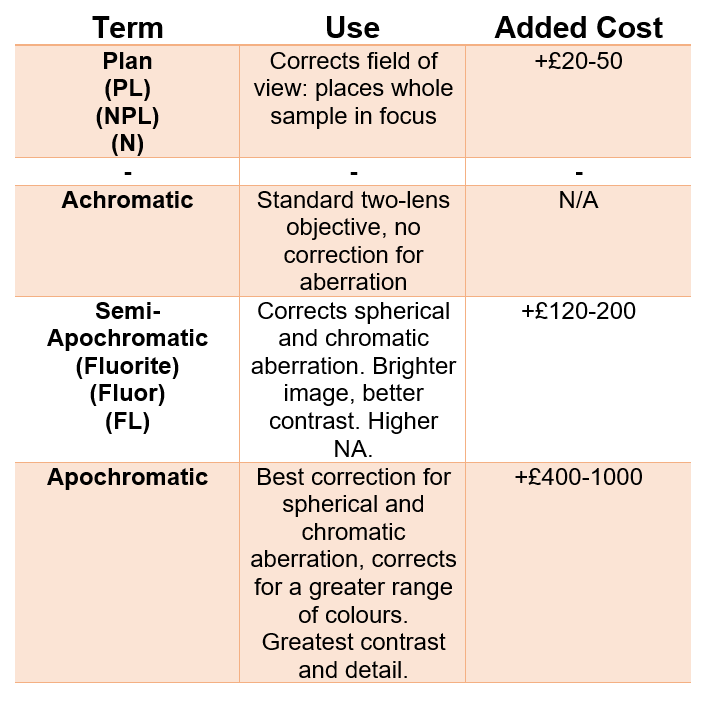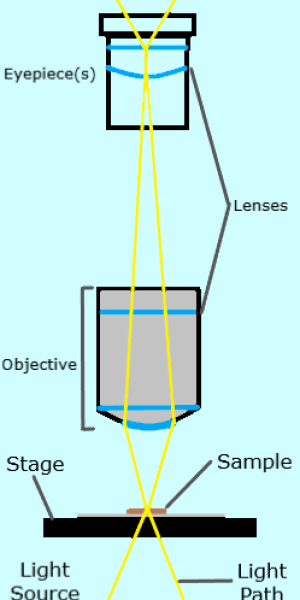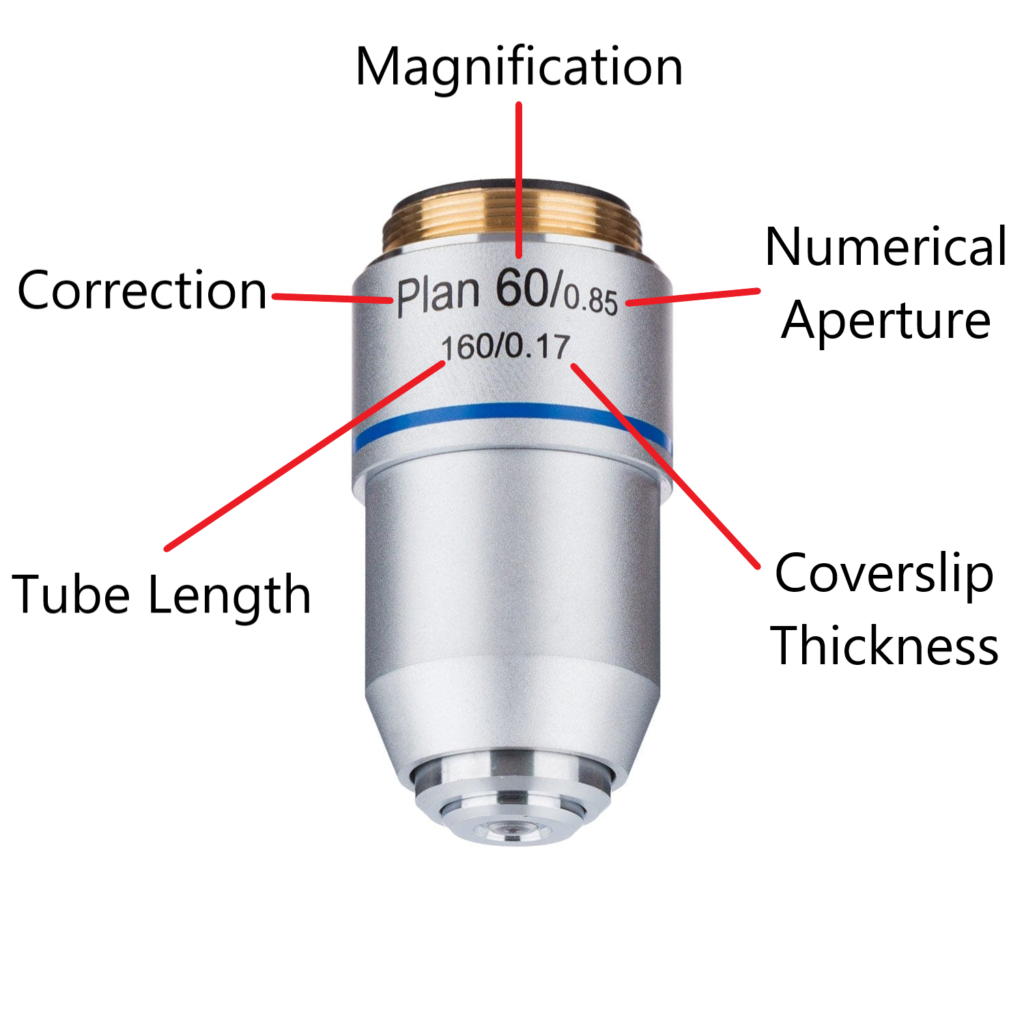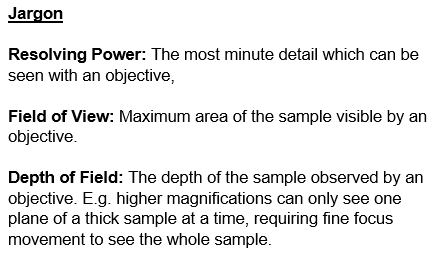Objectives
Objectives are the most essential components of a compound microscope. Like many other aspects in microscopy, the world of objectives if filled with jargon which is ready to confuse. This guide should hopefully A) explain simply what an objective is and B) clarify the various letters and numbers that distinguish different objective types.
What is an Objective?
An objective, is found above the stage on compound microscopes, typically as a silver or black tube. The objectives refract light passing through the object (sample) using lenses, directing it towards the eyepieces. Objectives vary in their magnification anywhere from 4-100x, although the most common magnifications are: 4x, 10x, 40x, and 100x, though this can vary depending on application or manufacturer.
The Jargon
There are four important variables with a compound microscope objective: Correction, magnification, numerical aperture, and field of view.
There are also three minor variables to consider: coverslip thickness, tube length and oil immersion.
Don’t worry! You can gauge almost all of these just by looking at the text on the objective, all you have to do is understand what means what! A lot of information is presented below, but you certainly don’t need to learn all of this, hopefully the table at the bottom should help you figure out what’s what if you’re in the market for an objective.
Type (Correction)
Infinity correction: A modern type of objective denoted with an infinity symbol, the benefit of infinity objectives is that the tube lengths remains the same at ~200mm no matter the magnification. This means that: A) you do not have to adjust the course focus when switching magnifications, so the sample remains in focus (parfocality) and B) more goodies can be squeezed into the objective and its light path, very useful for more advanced microscopy.
Benefits: Saves adjustment time, easy to purchase new, more modularity with different techniques e.g. filters.
Cons: Incompatible with non-infinity microscopes, generally fewer options, typically expensive.
Field Curvature Correction: One of the most important and desirble features of a compound microscope objective, field curvature correction keeps the entire field of view (sample) within focus. Standard non-field corrected objectives usually only have the centre of the sample in complete focus, with the edges appearing blurry. This is corrected by adding more lenses to the objective, keeping the whole field of view in focus. Obviously, this makes these objectives, known as plan objectives, more expensive; luckily, the advent of Chinese microscope manufacturing has sent prices down, where even starter microscopes likely come with plan objectives.
Aberation Correction: As light bounces through multiple lenses, it can get quite distorted with different wavelengths of light being filtered out as it passes through the glass. This causes the two main types of aberation: spherical and chromatic, making edges blurrier and causing colour fringing at the edges, whereby contrasting colours such as the sample edge and background look less stark. This can be corrected for by adding colour-correcting lenses and changing the lens material. Where normal (and by far the most common) objectives are called achromatic or achromats, aberation corrected objectives have different names depending on the correction, examples include: fluorite or fluor, semi-apochomatic, and apochromatic. Unlike field curvature, aberation corrected objectives can get very expensive and are often limited to cases where the highest resolving power is required. Aberation correction and field curvature correction are not mutually exclusive, you can, and in fact certainly will, have fluorite or apochromats which are plan.
Magnification
This is thankfully a lot more simple than correction. Magnification is what is says on the tin, typically ranging from 4x-100x, but never above 100x. The magnification on the objective is not the total magnification of the image sent through the eyepieces however, as the eyepieces also magnify the image, almost always by 10x, meaning the total magnification is the objective magnification x 10. E.g. 40 x 10 = x400.
Many people have different philosophies on which set of microscope magnifications are best: while the typical arrangement on new microscopes is 4x, 10x, 40x, and 100x, many prefer foresaking the 100x in favour of an intermediate magnification, such as 16x. This is because: A) 100x are very fiddly and almost always require oil immersion (back to this later), B) The resolving power and depth of field are poor at 100x, and C) intermediate magnifications are really nice to have, as the jump from 10x to 40x is quite large.
Numerical Aperture (and Depth of Field)
Numerical Aperture (NA) is the fair indicator of the resolving power and field of view of an objective i.e. the clarity and depth of the image. Numerical aperture is always lowest at lower magnifications and increases with magnification. A higher numerical aperture has a lower depth of field and vice versa, therefore at lower numerical apertures, most of the depth of sample can be observed, requiring fewer fine focus adjustments to see the whole sample. However, a higher numerical aperture also allows better resolution of details.
It is worth noting however that numerical aperture is only a single factor in determining resolution, while it’s a useful rough guide (especially for a non-physicist), it isn’t the be all and end all in determining resolution.
Other Bits
Coverslip thickness: Coverslips themselves have a range of thicknesses denoted by numbers ranging from 0-4, which in itself indicates the estimated thickness in mm. On objectives, the advised thickness for best resolution is printed on the tube in mm. The majority of the time the thickness indicated on the objective is 0.17(mm), corresponding to a coverslip thickness of 1.5. If this is new to you, don’t worry, it is very rare you’ll use a coverslip thickness (or objective) other than 1.5/0.17.
Tube Length: This is only really a concern for infinity objectives as I stated earlier. Almost all objectives which aren’t infinity corrected (or ancient) have a tube length of 160mm, whereas it ranges depending on manufacturer with infinity corrected objectives, which makes them incompatible with standard microscopes.
Oil Immmersion: This is actually quite important if you want to use higher magnifications >60x to look closely at blood samples or to observe bacteria, for example. As the focal length is so small at higher magnifications (distance between lens and object), immersion oil is used in place of a cover slip to improve the resolving power and increase the focal length, so you don’t go crashing your objective into the sample. These objectives are denoted by the word OIL on the side.
Okay, I think that’s it. Quite an information overload even when put simply. If you’re finding it hard to quantify all of this, hopefully the diagrams (right) and the table (below) help to quickly reference. See buying guide for advice as to what objectives are utlimately worth it base on my personal experience.




